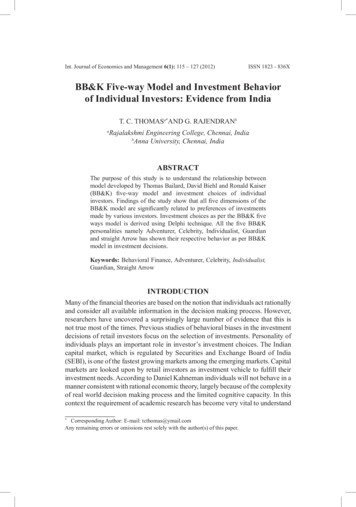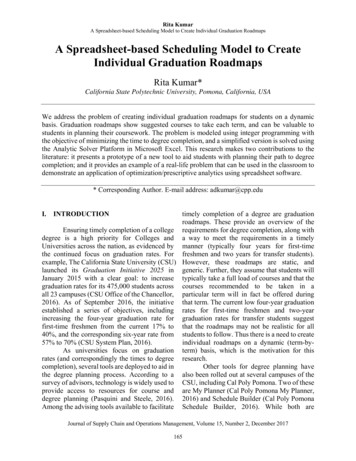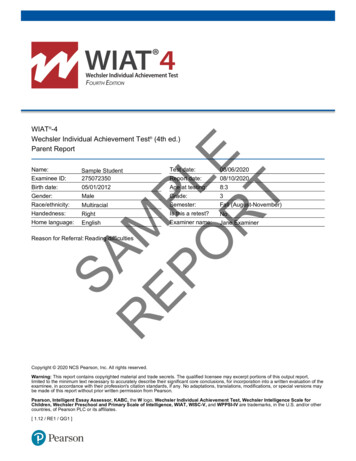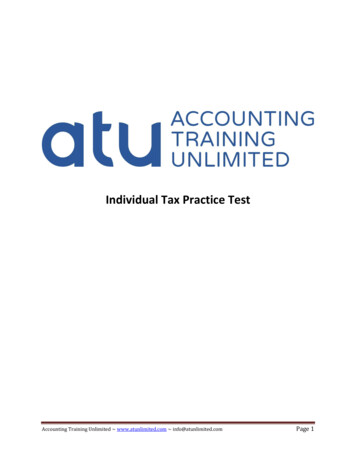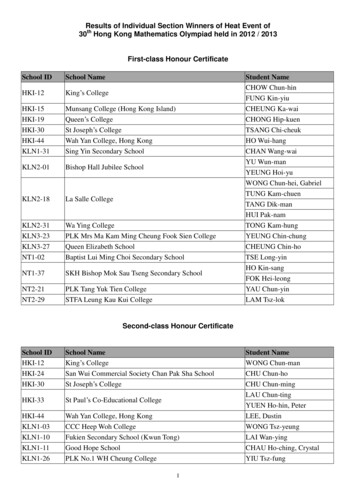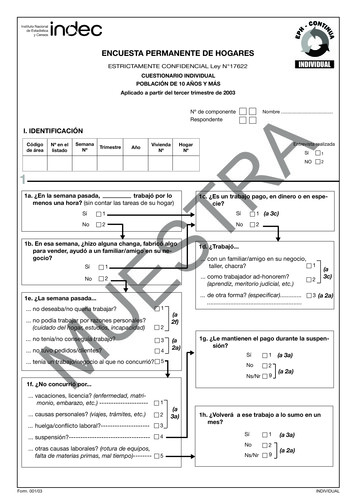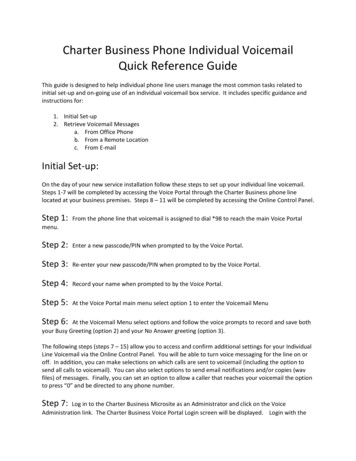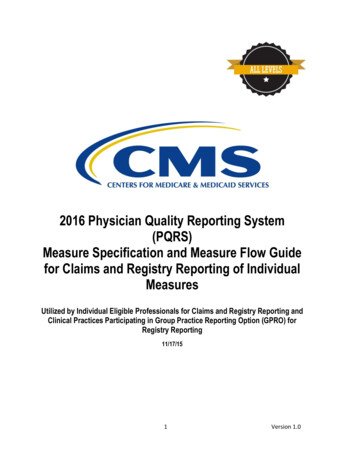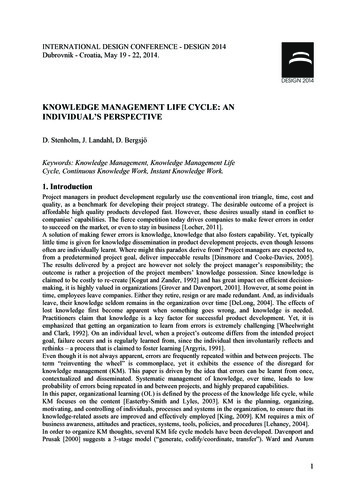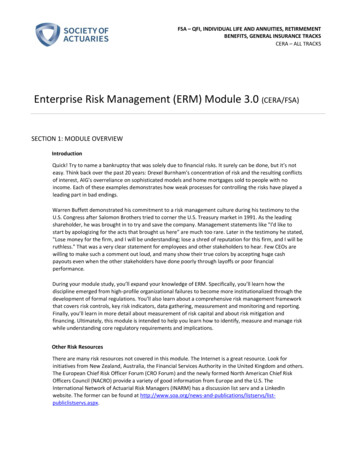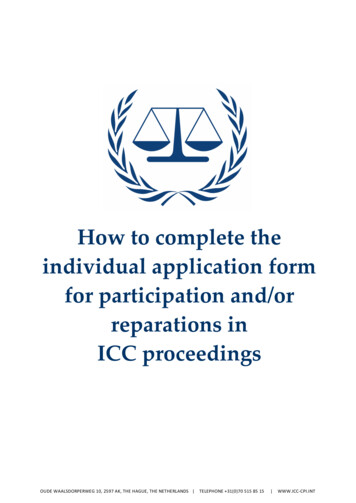
Transcription
How to complete theindividual application formfor participation and/orreparations inICC proceedings0OUDE WAALSDORPERWEG 10, 2597 AK, THE HAGUE, THE NETHERLANDS TELEPHONE 31(0)70 515 85 15 WWW.ICC-CPI.INT
How to complete the application form for participation and/or reparationsThese guidelines pertain to the application form which is designed for individual victims. Itdoes not refer to the form for groups of victims or organizations. Please complete thisapplication form if you or someone you are acting on behalf of has suffered harm as a result of acrime under the jurisdiction of the International Criminal Court (ICC), and wish to part icipateand/or submit a claim for reparations in proceedings before the ICC. The form has beendesigned to obtain all the information needed for your application.Before completing the form please read the following instructions carefully. They will help you fillout the form correctly. For a better understanding of the ICC and the victim participation process ingeneral, please refer to the ICC Victims Participation and Reparations Section (VPRS) informationbooklet on the ICC website.Every victim applying to participate and/or claim reparations in ICC proceedings must completetheir own separate application form. When filling in the application form: Please answer all questions as completely as possible. If some questions are not answered, orare only partially answered, the form may be considered by the ICC as incomplete. Please note the space limitations of this form. If more space is needed to answer certainquestions, please continue on a separate sheet of paper and attach it to the application form.The victim’s name and signature should be indicated on each sheet of paper attached to theapplication. Please write clearly, preferably in black.The ICC Judges will decide whether the applicant is a victim of a crime under the jurisdictionof the ICC, whether the applicant is entitled to participate in the proceedings and, in theevent of a conviction, whether the applicant is entitled to reparations. Applications which arenot transmitted to the judges remain in the custody of the Registry of the ICC.The judges decide whether the information contained in the form, including the applicant’sidentity, will be forwarded to the Prosecutor and to the Defence. Please note that some ofthe information provided may be made available to the public in the course of judicialproceedings.If the applicant has security concerns regarding their engagement with the ICC or relating toany information contained in the application form, these concerns should be written down inresponse to Question 6. Please be aware that, despite raising security concerns, informationrecorded in the application may still be shared with the judges and/or the parties duringthe course of proceedings.INSTRUCTIONS - APPLICATION FOR INDIVIDUAL VICTIMS’ PARTICIPATION2 / 12
Are you a victim, or a person acting on behalf of a victim?Throughout the application form, the person that suffered the harm is referred to as the victim.Please note the difference between a victim and a person acting on behalf of a victim for thepurposes of the ICC:A victim is: a person who has suffered direct harmas a result of a crime within thejurisdiction of the ICC (direct victim) a person who suffered harm as a resultof crime(s) targeting another personrelated to them (indirect victim).(For example, if the person is a family member of avictim who died or suffered other types of harm asa result of a crime within the jurisdiction of the ICC,he/she must fill in a form on his or her own behalfdetailing the crimes and his/her personal harmresulting from the loss of his/her family member).A person acting on behalf of a victim is:an individual who presents an applicationto the ICC on behalf of another person whois the victim. This is the case for: victims who are unable to present theirapplication themselves (children,persons with disabilities affecting theirability to present an application) victims who prefer to ask someone elseto present an application on their behalfand have given their consent forsomeone else to do so.Page 1ACDCDEBThis section refers to the victim, not the person acting on behalf of the victim.AA copy of proof of identity of the victim should be submitted with the form (for example, national identity card, birthcertificate, voting card, passport, driver’s license, student or employment card, letter from a local authority, campregistration card, card from a humanitarian agency, tax document). When you submit your application form by mail:Only attach copies of documents, not originals.If any information in the form is different from the information on the identity document provided (for example, namespelling, date of birth), please explain the reason for the difference next to the answer, or on a separate sheet clearlyreferencing the error/discrepancy.BPlease state the gender the victim identifies with.CIf the victim’s date of birth or age is unknown, please give an approximate date or age; if not possible, provide anyinformation that could assist in determining/approximating age.DEnter the victim’s nationality(ies). If the victim is stateless, this should be mentioned here.EIf applicable, enter the victim’s ethnic group or tribe.INSTRUCTIONS - APPLICATION FOR INDIVIDUAL VICTIMS’ PARTICIPATION3 / 12
Page 1 (continued)Victims may choose to participate in proceedings and request reparations using this form. If the victim would like toapply for both participation and reparations, the victim should tick the box “PARTICIPATION AND REPARATIONS”.Please note however, that pages three to five may be submitted separately and at a later date should the victimneed additional time to complete. Please also note that additional supporting documents related specifically toverifying reparation claims (that are not readily available at the time the victim completes the form) need not beincluded at this time for the validity of the form.Should the victim only wish to participate, meaning, providing their views and concerns about the courtproceedings through a lawyer who represents the victim in the courtroom, the victim should only tick the“Participation” box. If the victim only wishes to participate, the victim need only complete pages 1 and 2 of theapplication form. Please consult the VPRS information booklet for more information about participation in ICCproceedings.Should the victim only wish to request reparations, the victim should only tick the “Reparations” box.Reparations can be anything which can help the victim to redress the harm suffered. This can includecompensation, various forms of assistance, restitution of property, and/or symbolic or moral measures such aspublic apologies. If the victim only wishes to claim reparations, the victim still needs to complete all five pagesof the application form. Please consult the VPRS information booklet for more information about reparations.Please be as specific as possible about what happened to the victim. It is important to provide a clear descriptionof the facts and details of the victim’s personal impressions. It is in the interest of the victim to provide a clear andfactual account of the events that happened to the victim, precisely as he/she remembers them.If different events took place at different date(s) and/or place(s), please clearly explain each relevant event andrecord the date when it occurred.Please be specific. If possible, provide the exact date on which the incident(s) occurred (day/month/year). If thedate of the events is unknown, please give an approximate the date of events (for example, proximity to major,known events, like a religious holiday, elections, any public memorial, publicly reported armed attacks, as the casemay be). If possible, provide name of a town or city where or near to the place where the incidents occurred.Information should be provided about the exact nature of the injury, damage, or suffering that the victim haspersonally experienced as a result of the actions or events described in Question 2.The ICC recognises different types of harm that a victim suffers as a result of crimes that the ICC has jurisdictionover. These crimes can cause physical suffering to a person’s body, emotional or psychological suffering or mentalharm, by which a person’s mind is affected because of what he/she has experienced or witnessed.Material harm could also be recognised; for example loss of, or damage to property as the result of a crime in theICC’s jurisdiction. If the events resulted for example in impairment to work or loss of educational opportunities,please explain what the activity was and how the activity has been affected.INSTRUCTIONS - APPLICATION FOR INDIVIDUAL VICTIMS’ PARTICIPATION4 / 12
Please clarify if the victim still suffers from the harm. If so, please indicate if the continued suffering affects othersthat are dependent on the victim for financial or other support.If the victim has documents demonstrating the harm suffered, please attach copies to the form. This includes forexample medical records, proof of economic loss, proof of loss or damage to property or any other documentproving the harm caused as described.If the victim suffered harm as a result of crime(s) targeting their family member(s), in addition to documentsestablishing the identity of both the victim and the family member, proof of kinship (or close relationship) betweenthe two should be submitted together with the form. Examples include: (i) a birth, marriage or death certificate; or(ii) a declaration from two witnesses, together with copies of the witnesses’ identity documents.Finally, if possible, please attach copies of any documents substantiating the harm suffered (for example: deathcertificates, medical records, etc.).If the applicant does not know who the person(s) allegedly responsible for these events are, it is sufficient to providesome information that would identify the group to which the individuals belong (for example, a description of theuniforms worn by alleged perpetrators or language spoken by alleged perpetrators, etc.).If the victim does not know who is responsible for the events, the victim can simply reply “not known” in the boxprovided.SIGNATURES: It is very important that one or both of the two signature boxes on the bottom of Page 1 is completed.The box above (the first signature box on the form) is when a victim applies on their own behalf. By signing the form, theapplicant is verifying the authenticity of the application. This serves to demonstrate that the victim is taking responsibility forthe content of the information given in the form and its accuracy, even if someone else has actually written it down. Bysigning, the victim also confirms their intention to submit an application.If the person is not able to write, for example if they are illiterate, they may make a personal mark, or put their thumbprint.If the victim is an adult who gives consent for someone to act on their behalf, both persons (the applicant and the personacting on their behalf) should sign, or the applicant should provide their written consent in a document appended.ABC--D-INSTRUCTIONS - APPLICATION FOR INDIVIDUAL VICTIMS’ PARTICIPATION5 / 12
AVictim is a child: According to the Convention on the Rights of the Child, every person below the age of 18 is achild; therefore an adult related to the child has to present the application acting on their behalf. A document(copy) providing proof of kinship has to be attached to the application form. Proof of kinship could be any relevantofficial documentation attesting to such kinship (names & relationship). It can also be a declaration from twowitnesses, submitted alongside copies of their identity documents.BVictim has a disability: If the victim has a disability that affects their ability to present an application, then aguardian can present the application acting on their behalf. A document (copy) providing proof of guardianship hasto be attached to the application form. Proof of guardianship could be any relevant official documentation attestingto such guardianship (names and legal relationship). It can also be a declaration from two witnesses, submittedalongside copies of their identity documents.CVictim is an adult: If the victim is an adult and prefers that someone related to them presents the application ontheir behalf. In this case, it is very important that the victim expresses consent by attaching a letter of consentsigned by the victim, or by signing the victim’s signature box of Page 1. In both cases, the person acting on behalfneeds to sign the ‘person acting on behalf signature’ field.DProof of identity of the person acting on behalf of the victim must be attached to the form. Valid identitydocuments are: national identity card, birth certificate, voting card, passport, driver’s license, student or employeecard, letter from a local authority, camp registration card, card from a humanitarian agency, tax document or otherdocument identifying the person.---Before signing the form, the victim should either read the form in its entirety/ or have the person assistingthe victim read it back to him/her to ensure the accuracy of the information provided.After the form is signed by the victim, the form should not be altered in any way (for example, by adding orremoving information). If the victim wishes to modify his/her declaration, he/she should contact the VPRSwhich will provide a specific form to that effect.Page 2: Personal informationPlease explain the reasons that motivate the victim to participate in the ICC proceedings. For example, “to helpestablish the truth”; “to obtain justice”; “to obtain reparations”, etc.The victim can express their concerns, not only about physical security but also about harm to their psychologicalwell-being, reputation, privacy and/or dignity or those of their family as a result of their relation and interactio
Before signing the form, the victim should either read the form in its entirety/ or have the person assisting the victim read it back to him/her to ensure the accuracy of the information provided. After the form is signed by the victim, the form should not be altered in any way (fo r example, by adding or removing information). If the victim wishes to modify his/her declaration, he/she should contact the VPRS

